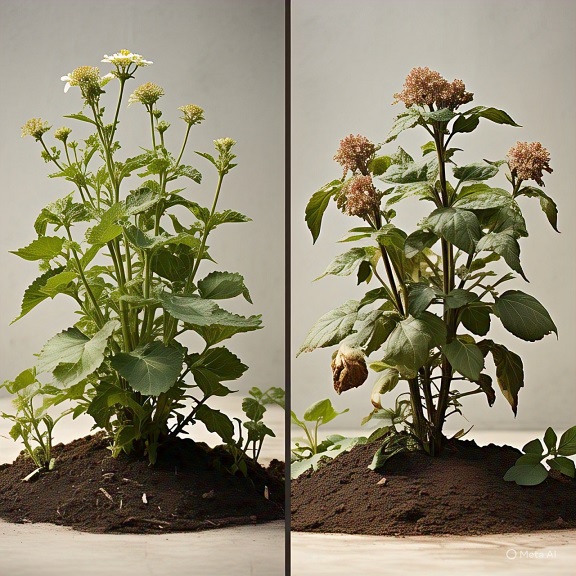Have you ever planted a tiny seed and watched in awe as it sprouted into a thriving plant? The process of how do plants grow is nothing short of a natural miracle. From the smallest herbs to the mightiest oaks, every plant follows a carefully orchestrated life cycle, fueled by sunlight, water, and nutrients.
In this blog, we’ll explore the science behind plant growth, the essential requirements for healthy development, and the key stages every plant goes through. Whether you’re a gardening enthusiast or just curious about nature, understanding how do plants grow will deepen your appreciation for the green world around us.
Table of Contents
The Essentials: What Do Plants Need to Grow?
Plants, unlike animals, can’t move around to find food, then how do plants grow? They rely entirely on their environment. To thrive, they need five critical elements:
1. Light – The Energy Source
Sunlight is the primary driver of plant growth. Through photosynthesis, plants convert light energy into chemical energy (glucose), which fuels their growth. Without enough light, plants become weak and leggy as they stretch toward the nearest light source.
🔹 Fun Fact: Some plants, like snake plants and pothos, can survive in low light, but most need at least 6-8 hours of sunlight daily.
2. Water – The Lifeblood
Water plays multiple roles in plant growth:
- Dissolves nutrients in the soil for root absorption.
- Helps transport minerals and sugars throughout the plant.
- Maintains cell structure and prevents wilting.
🚫 Too much water? Roots rot. Too little? Plants wither. Balance is key!
3. Air – The Breath of Life
Plants “breathe” in two ways:
- Carbon dioxide (CO₂) – Used in photosynthesis to make food.
- Oxygen (O₂) – Needed for respiration (breaking down food for energy).
🌬️ Tip: Good airflow prevents fungal diseases and strengthens stems.
4. Nutrients – The Building Blocks
Plants extract essential minerals from the soil, including:
- Nitrogen (N) – For leafy growth.
- Phosphorus (P) – For strong roots and flowers.
- Potassium (K) – For overall health and disease resistance.
🌱 Pro Tip: Fertilizers replenish soil nutrients, but overuse can harm plants.
5. Temperature – The Growth Regulator
Every plant has an ideal temperature range:
- Too cold? Growth slows or stops.
- Too hot? Plants may wilt or bolt (flower prematurely).
🌡️ Example: Tomatoes thrive in warm weather, while lettuce prefers cooler temps.

The Stages of Plant Growth: A Step-by-Step Journey

Now that we know what plants need, let’s explore how do plants grow through their life cycle:
1. Germination – The Awakening
A seed lies dormant until conditions are right (moisture, warmth, oxygen). Then:
✅ The seed absorbs water, swells, and cracks open.
✅ A tiny root (radicle) emerges downward.
✅ A shoot (plumule) pushes upward toward the light.
🌰 Did You Know? Some seeds, like lotus, can stay dormant for years before sprouting!
2. Seedling Stage – The Delicate Beginning
The young plant develops its first true leaves and starts photosynthesis.
⚠️ Dangers: Seedlings are fragile—overwatering, pests, or lack of light can kill them.
3. Vegetative Growth – The Powerhouse Phase
The plant focuses on growing stems, leaves, and roots.
📈 Fast Fact: Bamboo can grow 3 feet in a single day during this stage!
4. Flowering Stage – The Beauty of Reproduction
Mature plants produce flowers to attract pollinators (bees, butterflies).
🌸 Note: Some plants, like spinach, bolt (flower too soon) if stressed.
5. Fruiting & Seed Formation – The Circle of Life
After pollination, flowers develop into fruits or seed pods, ensuring the next generation.
🍎 Example: A single apple tree can produce thousands of seeds in its lifetime!
Factors That Affect Plant Growth

Even with perfect conditions, some factors can make or break a plant’s health:
✔ Soil Quality
- Rich, well-draining soil = Happy roots.
- Compacted or poor soil = Stunted growth.
✔ Watering Habits
- Consistent moisture is better than erratic soaking.
- Morning watering reduces evaporation and disease risk.
✔ Light Exposure
- Full-sun plants (e.g., sunflowers) need 6+ hours of direct light.
- Shade-loving plants (e.g., ferns) thrive in indirect light.
✔ Pest & Disease Control
- Aphids, fungi, and weeds compete for resources.
- Organic solutions (neem oil, companion planting) help protect plants.
Final Thoughts: Nurturing Your Green Friends
Understanding how do plants grow empowers you to become a better gardener. Whether you’re growing vegetables, flowers, or houseplants, providing the right balance of light, water, nutrients, and care will ensure they flourish.
Next time you see a sprout pushing through the soil, remember—it’s not just growing; it’s following millions of years of natural wisdom. 🌿✨
Do you want to read more about science. check this out: 1] What is Gravity? 2] Easy Science Experiments for Kids 3] What is Electricity? 4] What Causes Earthquakes? 5] Why is the Sky Blue?
